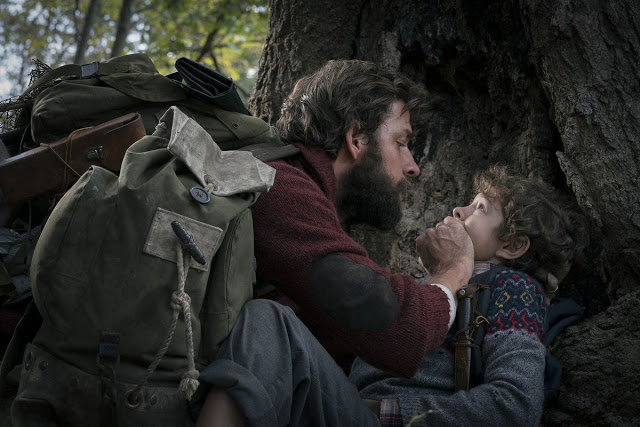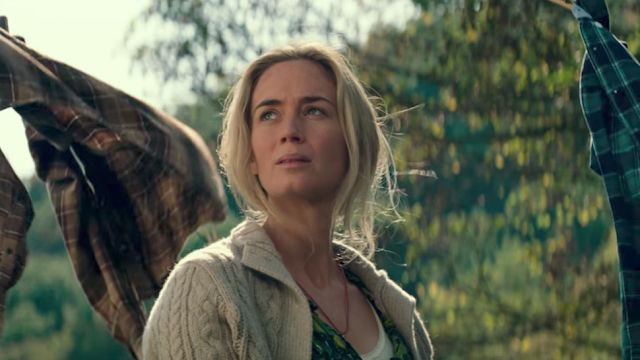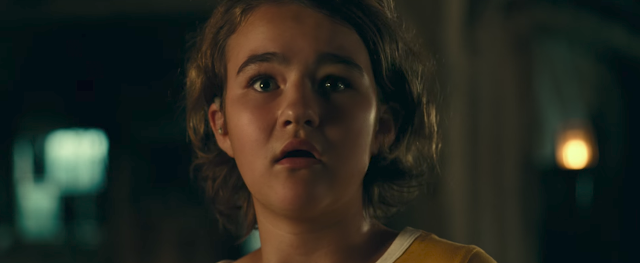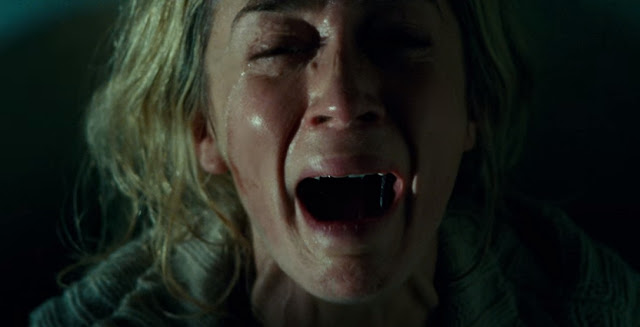We begin with a stark title card: “Day 89.” A family prowls through a deserted pharmacy, the mother scanning labels on vials while the kids amble through the aisles and pluck goodies from the shelves. It’s a familiar scene to fans of apocalyptic fiction, the dusty sills and sparse surroundings recalling similarly ominous openings from movies like 28 Days Later and I Am Legend. The key difference here is that the characters, plainly well-versed in this foreboding new normal, take special care not to make any noise whatsoever. Yet before long, a mistake is made, a sound is blared, and in the blink of an eye and the rustle of some leaves, a life is taken.
And with this brief and riveting and ghastly cold open, A Quiet Place announces itself as an expertly conceived and executed horror film, perhaps the best of its kind since It Follows. Combining a knockout premise—stop, hey, what’s that sound?—with white-knuckle set pieces and a bracing degree of economy, the movie both elevates your pulse and digs under your skin. It’s scary, sure, but not so scary that it prevents you from admiring it as a polished, fiendishly inventive piece of pulp art.
Put differently, it is not what you’d expect from the dude who played Jim in The Office. True, John Krasinski has directed movies before, but his debut was the misbegotten David Foster Wallace adaptation Brief Interviews with Hideous Men; the only thing scary about that movie was how horribly it drowned itself in a swamp of absurdly ornate dialogue. (I haven’t seen his follow-up, The Hollars, but it’s apparently one of those “prodigal son returns home” films, so I’m guessing nobody gets gruesomely murdered in it.) Yet A Quiet Place carries itself with a poise and patience that suggests it’s the product of a genre veteran. Working from a spec script by Bryan Woods and Scott Beck that he subsequently modified, Krasinski doesn’t reinvent the wheel with his directorial style, relying instead on durable horror tropes and sturdy pacing. But there’s a streamlined professionalism to his work that feeds into the movie’s relentlessness, the way it suffers neither fools nor exposition.
Indeed, one of the smartest and most satisfying things about this movie is its simplicity. There are no fill-in-the-blank flashbacks or explanatory voiceovers; in fact, there are hardly any voices heard at all. (As an added bonus, this means that when the characters do speak, it’s jarring and weirdly unsettling.) Virtually everything we learn about this grave new world derives from some notes conveniently scrawled on a whiteboard that we glimpse on occasion. The basic picture is all we need: Civilization has been overrun by enormous, fearsomely fast, blind creatures with giant cochleae who hunt by sound rather than sight. Three such beasts currently stalk the woods that encircle our central family’s living quarters, a spartan farmhouse nestled within endless rows of corn that may remind viewers of M. Night Shyamalan’s Signs.
Clocking in at just 85 minutes, A Quiet Place isn’t especially ambitious in its agenda; it’s a blunt survival story about people whose existence involves a lot of running, hiding, and hushing. Given that, it’s remarkable how much detail and color Krasinski packs into the film, building out its minimal premise in clever and compelling ways. Most of this is functional, as even basic scenes silently illustrate the myriad adjustments people have made—how they always walk barefoot, how they’ve layered soil along pathways to muffle their footsteps, how they’ve painted certain floorboards to signify the least creaky spots in the house. But this exactitude also extends to minor flourishes that become exotic in their mundanity, like how the plastic houses and hotels in a Monopoly set have been replaced with green and red tufts. As straightforward as it is, A Quiet Place exists in a universe that’s been constructed with exceptional care.
If this level of granularity doesn’t quite reach the film’s characters, that’s more a byproduct of Krasinski’s disciplined storytelling than a sign of artistic failure. Besides, it isn’t as though he disregards the human element; to the contrary, he takes pains to map out the fraying emotional lines that crisscross his primary foursome. They are the Abbotts, or at least, that’s what the credits call them; I don’t recall any names exchanged during the film itself (another indicator of the movie’s disdain for exposition). As apocalyptic nuclear families go, they could be doing worse, but while the marriage between Krasinski’s Lee and Emily Blunt’s Evelyn is appreciably tender—a lovely scene where they share a pair of earbuds and sway silently to a classic-rock ballad evokes one of the most romantic moments between Jim and Pam in The Office—the more fraught relationship is between Lee and Regan (Millicent Simmonds), their deaf pre-teen daughter. Some time ago, a tragedy reduced the Abbotts’ ranks from five to four, and Regan—convinced that Lee blames her for the incident—regards her father with surliness and mistrust. In that sense, she’s no different from many young girls, except here, refusing to listen to your father dramatically increases your chances of getting killed.
It’s an intriguing dynamic that isn’t entirely credible, in part because Krasinski’s performance is almost too sympathetic. With his wide eyes and sensitive features, he makes Lee a man of obvious decency and nobility—in one of the film’s few dialogue scenes, Lee has a heart-to-heart with his son, Marcus (Suburbicon’s Noah Jupe), where he verbalizes his affection for his daughter—so much so that it seems absurd that Regan would view him with petulance rather than gratitude and outright love. (Their bickering occurs through sign language, of course, and while some might call that facility a contrivance, it actually makes sense; in a dystopia where most people were presumably slaughtered, the Abbotts’ ability to sign represents a Darwinian advantage, explaining how they’ve stayed alive this long.) But Simmonds, as she showed in Wonderstruck, is an eerily persuasive actress, and she communicates Regan’s wounded self-loathing with piercing clarity, demonstrating how a strong performance can add depth and shading to an otherwise prosaic character. The same is true of Blunt, Krasinski’s real-life wife, who imbues the family matriarch with a compelling combination of steely toughness and genuine panic.
Mostly, though, A Quiet Place is memorable as a ruthlessly efficient supplier of gripping suspense. In a refreshing development, the film features a relative paucity of jump scares, with Krasinski preferring to ladle out the dread with unnerving patience. From a design perspective, the creatures themselves are nothing special; they’re basically a hybrid of Alien’s xenomorphs and the sightless crawlers from The Descent, only with grotesque, enormous ears (the better to hear you with). But their familiarity in no way dampens their danger, and they terrorize their prey in a variety of excruciating situations. In a brilliant twist on the “woman in peril” formula, Evelyn spends much of the movie heavily pregnant, provoking questions about just how the Abbotts will deal with the baby’s arrival; the answer, we learn, involves a tiny oxygen mask, a lidded crib, and a leap of faith. In one scene, a grain silo becomes a den of quicksand, while in another (one that echoes Jurassic Park), the cab of a pickup proves perilously vulnerable. The film’s pièce de résistance is a game of silent cat-and-mouse featuring a nail, an egg timer, some portentous red lights, and an agonizingly suppressed scream; it’s a brutally effective sequence that will have you covering your eyes even as you strain your ears.
That’s basically the default mode of viewing for A Quiet Place, which—much like Don’t Breathe a few years ago—uses sight and sound to tell a gratifyingly simple story with craft and wit. Reports have already begun circulating that audiences are leery of eating popcorn during the movie, not wanting to disturb its carefully cultivated silence. That’s telling, but A Quiet Place is so furiously watchable, you won’t just be scared of making the slightest noise; you’ll also be afraid to blink.
Jeremy Beck is the editor-in-chief of MovieManifesto. He watches more movies and television than he probably should.




